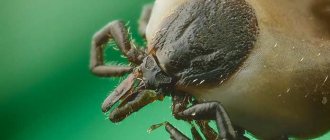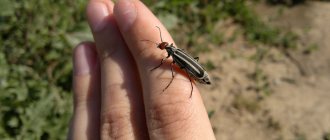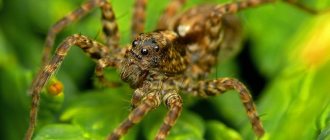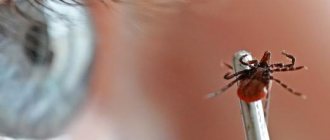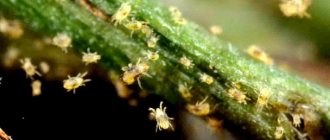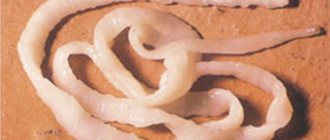In previous articles, we examined in detail such representatives of the ixodid family as taiga and dog ticks, which are most common in the central zone of our country. Having the ability to infect humans with complex infectious diseases, they attract more attention from us.
However, the Ixodid family includes another type of tick, which has many names - deer, bear, black-legged or simply black tick. This type of parasite does not officially live on the territory of our continent; its habitat is mainly North America. But it is worth noting that single representatives of the parasite can be found on any landmass of the planet, with the exception of regions with permafrost.
Considering the peculiarities of the distribution of the black tick, the material in this article may be useful to tourists, travelers, as well as those readers who want to broaden their horizons in the field of entomology of ixodid ticks.
General information about the black mite
The black-legged tick (Ixodes scapularis) is commonly known as the deer tick, black-legged tick, or black-legged tick due to the intense lacquered black coloring of its limbs. The tick's habitat is primarily on the west coast of the United States, but is found throughout the continent. Like most members of the ixodid family, the black tick is a carrier of several animal and human diseases - Lyme disease, babesiosis, anaplasmosis and others. The true host of the black tick is the white-tailed deer, and it is precisely because the parasite is most often found on this animal that it has earned its second name, the deer tick. The tick also attacks mice, lizards and migratory birds; this phenomenon is especially often observed at the larval or nymphal stage of the parasite.
How does the black mite differ from other species?
First of all – color. In this case, the tick is black and shiny (as if it had been coated with varnish) and has 4 pairs of limbs. The black mite is not a separate species of mite, and in scientific circles such a concept does not exist at all. They are popularly called black because they are black in color. In fact, the black tick is a subspecies of ixodid ticks, of which there are more than 60 species.
Now you can imagine what a black tick looks like. If you find it on your body or the body of your pet, remove it, put it in a jar and take it for analysis (not every individual carries the disease). We also recommend looking at a photo of a black tick to know what it looks like.
Features of behavior
I. scapularis has a life cycle of two years, during which it passes through three stages: larva, nymph and adult. The tick must take a portion of blood at each stage of its life cycle before maturation, otherwise the transition to the next stage will be impossible.
The black tick is one of the species of ixodids in which the process of feeding on blood takes a long time. After landing on a victim, the parasite quickly finds a place to bite, but the process of taking blood continues for four to five days. As noted above, white-tailed deer are the preferred host of the black tick, but they are also well known to attack small rodents.
After the parasite gets drunk, it falls to the ground and hibernates in the fallen leaves of the undergrowth. The following spring, the female lays several hundred to several thousand eggs in clusters.
Ixodid ticks are very hardy creatures and I. scapularis is no exception. They are active even after severe frosts, since daytime temperatures can warm them enough to keep them in the desired host-seeking activity. In the spring, they may be one of the first invertebrate animals to emerge after winter.
Consequences of a bite
In addition to Lyme disease, or borreliosis, the black tick is dangerous to humans as a carrier of several other types of pathogens, such as Theileria microti and Anaplasma phagocytophilum, which cause the diseases babesiosis and human granulocytic anaplasmosis, respectively. Concurrent infections are often possible—among early patients with Lyme disease, depending on their geographic location, 2-12% also have anaplasmosis and 2-40% have babesiosis. Co-infection will complicate Lyme symptoms, but diagnosis and treatment are especially difficult in this case.
Although large mammals are the preferred hosts of ticks, deer cannot transmit Lyme disease pathogens to ticks. They acquire Borrelia while feeding in their early stages on infected mice and other small rodents.
Guinea fowl, backyard chickens, and fire ants are known predators of mites. However, in the wild, an increase in populations of this ant species has no effect on reducing the concentration of mites.
Species diversity
What types of ticks are there, what do they eat and where do they live? These questions are asked by novice entomologists and simply nature lovers.
Saprophages
A large number of mites belong to the group of saprophages. They feed on organic debris and do not pose a threat to humans. The lifestyle and significance in nature is similar to earthworms. Saprophages contribute to the formation of soil humus. A typical representative of this group is the oribatid mite. It is the dominant species found in forest soil. Their number reaches hundreds of thousands of individuals per 1 m2. The size of adult individuals is 0.7-0.9 mm, their body is black.
Oribatids are an important link in the soil food chain. Oribatid mites have slow metabolism and development. The life cycle from egg to adult takes from several months to 2 years.
Phytophages or plant mites
Among arthropods, many species feed on plant sap or their remains. Phytophages are pests of indoor plants and agricultural crops. Their habitats are leaves, buds, roots, and bulbs. What types of mites can be found on plants?
Mites live in colonies, hiding on the backs of leaves. Favorable conditions for their development are temperatures of 27-28 0 and low humidity. Larvae and adults feed on plant sap. If not treated with acaricidal preparations, spider mites can destroy the entire crop. On indoor plants, in addition to the common spider mite, you can find other species: Atlantic spider mite, red-legged spider mite.
Gall mites are members of the family of dangerous pests of forest trees and cultivated plants. They settle on apple trees, plums, pears, and grapes. They are small in size - 0.1-0.3 mm. The body is spindle-shaped and has four legs. Pests suck sap from tissues, causing deformation and the formation of galls (pathological formations on leaves, roots and other parts of plants).
Barn
This group of mites feeds on solid food - grain, flour and other products. Barn mites are distinguished by their viability and wide distribution. They settle not only in places where human supplies are stored, but also in animal burrows. They can be found in the soil, on tree roots, in mosses, and above-ground parts of plants.
Information. Argasids are capable of starving for 11 years.
Gamazovy
- egg;
- larva;
- nymph 1;
- nymph 2;
- adult.
Life expectancy is 7 months.
This order includes the predators Phytoseiidae, used in the fight against plant pests. Mites measuring 0.2-0.8 mm are natural regulators of the number of phytophages. Their body is oval in shape and covered with bristles. For movement, 4 pairs of legs are used. A popular species of the predatory family, Phytoseiulus, is produced to destroy spider mites in open, closed ground (in greenhouses). Its color ranges from orange to cherry. The male is smaller than the female and can only be seen through a microscope.
Information. Predator nymphs destroy spider mite eggs, which are insensitive to many insecticidal drugs.
Red mites
The diversity of tick species is part of nature. Only a small part of these small animals pose a danger to humans. Most of them, due to their microscopic size, remain invisible to us.
Ticks belong to the class of arachnids. More than 48,000 species of ticks are known. Ticks live in all climatic zones, on all continents. Not all ticks are dangerous to humans. Most varieties feed on decaying organic matter, fungi, and plants and contribute to the formation of humus, a nutrient layer of soil.
Most ticks are very small - up to 0.4 mm. But some species reach a size of over 1 cm. A tick that has sucked the blood of an animal or person can grow up to 2.5 cm. Ticks that feed on the blood of animals and people carry various infections and viruses, including deadly ones. Therefore, everyone should definitely know which ticks are dangerous to humans, what they look like, where they live, and what danger they pose.
Some features of the black tick development cycle
Black mites live for two to three years and feed only three times in their entire lives. The life cycle begins when the female lays eggs. As the eggs mature, they hatch into larvae, which then molt into nymphs and finally, also through the molting process, the nymphs emerge into adults.
Larvae emerge from eggs, as a rule, from May to September, that is, the entire warm period of the season. Here are a few characteristics of this stage of the mite:
- initially the larva is sterile, it does not carry pathogens of diseases such as Lyme disease, human anaplasmosis or babesiosis;
- the first causative agent of the disease, the larva receives a portion of blood from the carrier or sick host during its intake;
- the larvae usually attack white mice, voles, or bite the legs of other small mammals;
- if a mouse is infected with pathogens, the larva becomes infected and is now able to transmit these pathogens during its second or third feeding (nymph or adult stage);
- immediately after feeding, the larvae molt into nymphs and become passive until the following spring.
In the spring and summer of the second year, primarily from May to early July, the nymph becomes active and feeds for the second time in its life. Peculiarities:
- If a tick carries a pathogen acquired during its first feeding as a larva, it may transmit the pathogen during its second feeding.
- If the nymph has not yet been infected, it may become infected if the second host carries pathogens.
- The nymph is the size of a poppy seed. Therefore, it is very difficult to distinguish them externally; they often look like a speck of dirt or freckles on human skin.
Some facts about the black tick
- Black ticks feed on blood by inserting their proboscis into the wound, which is equipped with sharp growths that prevent the tick from falling off until the feeding process is completed.
- They are very slow bloodsuckers - to get their fill of blood, they need a period of 3-5 days.
- If black-legged ticks are infected with an infectious agent, the blood-sucking time must take at least 24-48 hours before the parasite is able to infect a person with Lyme disease. Human anaplasmosis takes slightly less time to become infected - at least 12-24 hours.
- Ticks live in wooded, brushy areas that provide food and cover for populations of white mice, deer and other mammals.
- This habitat also provides the parasites with the moisture levels they need to survive.
- The highest concentration of ticks is in the forest (especially along highways) and grass areas at the forest border.
- Ticks wait for potential prey at the tips of low-lying vegetation and the lower branches of shrubs. They don't crawl into trees.
- Typically, ticks attach to a person or animal near ground level.
- Like all ixodids, black ticks only crawl, they do not jump or fly. They grab with their front paws the clothes of people or the fur of animals that pass by, and then the bloodsuckers crawl up to find a place to bite.
- White-tailed deer live throughout most of the United States, but the black-legged tick can only be found in certain regions of the country.
What does a tick look like (photo)
The taiga tick lives in the Asian and several regions of the European part of our country. His brother in arms, Ixodes ricinus, is more likely to be encountered by those who, like our family, settled in the south of Russia. Here is a comparative photo of all varieties of this specimen:
Ixodes Ricinus. Male, nymph, female and tick larva
I showed my husband the photo, he said that he more often removed males from their trousers than females. I was also surprised why some mites are black, while others have a reddish tint. All ticks of this species have a powerful shell and four pairs of legs. The reddish tint of the female is due to the fact that the integument of the back part is capable of greatly stretching and absorbing hundreds of times more blood than the weight of a hungry tick.
Here is such a cute female of the genus Ixodes
To our great happiness, we did not meet a female that had drunk blood, but I will also show you a photo. For comparison and greater ostracism. God forbid you encounter something like this:
Female ticks feed for 6 to 10 days. Now let's look at the male. It is smaller and not as bloodthirsty as its “weak” half - it sticks for a short time (less than an hour). Look carefully at these photos and remember what the male and female Ixodes ricinus look like. They don’t have eyes, but they have a very strong sense of smell: they can smell prey ten meters away.
By the way, if you were bitten by a male and you didn’t notice him right away, the situation may become more complicated. After drinking blood, the tick falls off and you are rewarded with a reddened spot on the skin, the origin of which you can only guess. If you do not find out in time the nature of this stain, you risk finding yourself in a dangerous situation.
How to protect yourself from a tick bite
Black ticks live in shady, damp areas at ground level. They will cling to tall grass, inflorescences and bushes, usually no more than one and a half meters from the ground. They are also abundant in lawns and gardens, especially along woodland edges and around old stone walls. As already noted, parasites cannot fly or jump, nor do they fall on passing people or animals. All the conditions discussed below will be true for “our” parasites - taiga and dog ticks.
In tick-infested areas, the best defense against the parasite is to avoid contact with soil, leaf litter and vegetation. However, if there is a need to hike, camp, hunt, or otherwise spend time outdoors, everyone can protect themselves by:
- Wear light-colored clothes made of thick fabric. It's so easy to see the tick.
- Wear high-top shoes with the legs tucked in and a long-sleeved shirt.
- Check clothing and any exposed skin as often as possible while outdoors.
- Consider using repellents.
- Try to move on cleared, well-trodden trails in their center. Avoid dense forests and bushy areas.
- Avoid sitting directly on the ground or on rock walls.
- Keep long hair tied up.
- Shower as soon as possible after returning indoors, preferably within two hours, to wash off or easily locate any ticks that may be on your body.
- Do a final, full body check at the end of the day. Children and pets should also be checked. Found ticks must be destroyed.
Which ticks are dangerous to humans?
Here are some types of ticks that can cause harm to humans, from the least dangerous to the most dangerous ticks in the world:
- Granary mites (flour, grain). They live in places where cereals, grains, and flour are stored. They can attack people and cause allergic reactions. They quickly leave the human body, as they prefer plant foods.
- Bed mite. Lives in blankets, pillows, mattresses, carpets, house slippers. It feeds not on human blood, but on dead cells that every person loses every day (for example, in the form of dandruff). The danger to humans is an allergic reaction to mite secretions, which can manifest itself in itching, skin rashes; in the most severe cases, bed mites cause bronchial asthma.
- Dust mite. Lives in the dust of an apartment. The life activity and danger are similar to the bed tick.
- Scabies mite (itching). It has a very small size, up to 0.3 mm, and is almost impossible to notice on the skin. The tick is transmitted from one person to another by touching, shaking hands, or sharing household items. The tick drills tunnels in the upper layer of the skin and moves along them. The activity of the mite causes severe itching.
What chemicals are best for protection against ticks?
The following drugs have the most effective acaricidal effects against ixodid ticks:
- DEET. Such substances can be applied to exposed skin. Products containing 20% or more DEET may provide protection that lasts up to several hours. Use the lowest concentration needed for the amount of time you plan to spend outdoors.
- Picaridin is a colorless and odorless ingredient that can be applied to exposed skin at levels ranging from 5 to 20% of the active ingredient.
- Permethrin. Clothing, shoes and personal items can be treated with products containing permethrin. Its protection can last for many washes. Never use permethrin on your skin.
Precautions when using repellents that contain these active ingredients:
- Keep all anti-tick products out of the reach of children and read all label instructions before applying.
- Do not allow children to apply repellents on themselves.
- Do not apply repellents directly to the skin of the body. First you need to apply the product to the palms of your hands. And then treat the skin of the body. The exception is sprays.
- When using repellents, avoid contact with the eyes, mouth and nasal cavity.
- Do not apply repellents to skin damaged by sunburn, cuts, bruises, or other conditions such as psoriasis.
- Avoid prolonged and excessive use of repellents.
- Do not use repellents in enclosed spaces.
- Do not apply them directly to your face.
- Do not apply near eyes, nose or mouth.
- Wash treated skin upon return.
- If you think you or your child have had an adverse reaction to a repellent, wash the treated area immediately and contact your local health care provider.
How could a new species of ticks appear?
At the moment, scientists cannot answer this question with certainty. Information about the hybrid first appeared in 2009. Experts believe that the new species was formed due to the fact that both types of ticks live in the same territory.
Presumably, birds brought the Pavlovsky mite to the Novosibirsk region. Another version is that it appeared there due to the fact that in the 1960s and 1970s, anti-tick treatments were carried out near Akademgorodok and on its territory, which destroyed the taiga tick. And then, when these arthropods, familiar to the given territory, again became as numerous as before treatment, they crossed with Pavlovsky’s mites that had managed to occupy the empty “niche.”
By meeting in the same area, or even on the same animal, the two species produced a hybrid that turned out to be fertile. Experts believe that in some of the hybridizations a very successful combination of genes occurred. One of the features of the new species is that it can survive in conditions that suit both one parent species and the other.
How to safely remove a tick
If you find an embedded tick, there is no need to panic. Not all ticks are infected, and your risk of contracting an infection is greatly reduced if the tick is removed within the first 36 hours.
To remove a tick:
- Use simple tweezers to grasp the tick as close to the surface of the skin as possible.
- Pull firmly and steadily vertically upward. Do not pull or twist the tick.
- Place the parasite in a small container of alcohol to kill it. Or just burn it.
- Clean the bite area with alcohol, hydrogen peroxide, or iodine.
The bite site should be monitored over the next 30 days for the appearance of a rash. If a rash or flu-like symptoms begin to appear, contact your doctor immediately. Although it is not generally recommended that you take antibiotics for three days after a tick bite, it may be helpful for some people. This applies to tick bites that occurred in areas where Lyme disease is common and there is evidence that the tick was bitten for more than one day.
Bite symptoms
The fact is that it is impossible to immediately determine and detect the moment of a tick bite, since it does this absolutely painlessly by introducing natural anesthetics under the skin. However, after a few hours, the following symptoms may appear:
- slight nagging pain;
- mild subcutaneous itching;
- increased body temperature;
- headache;
- visible enlargement of lymph nodes;
- rash on the body.
These symptoms indicate the penetration of infection into the blood and the beginning of infection.
